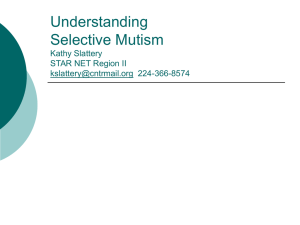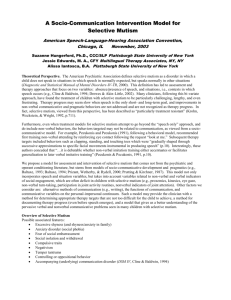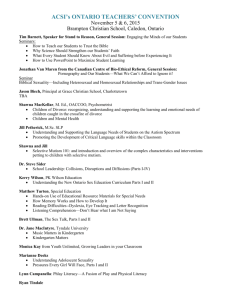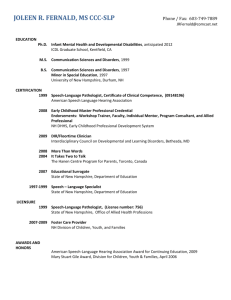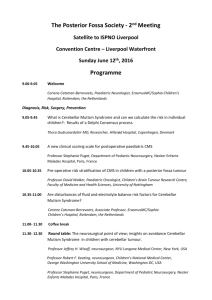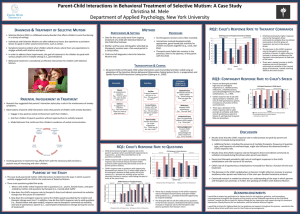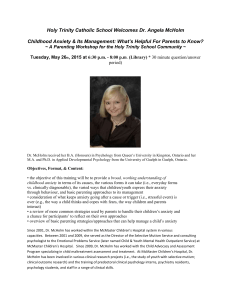Selective Mutism - Speech
advertisement
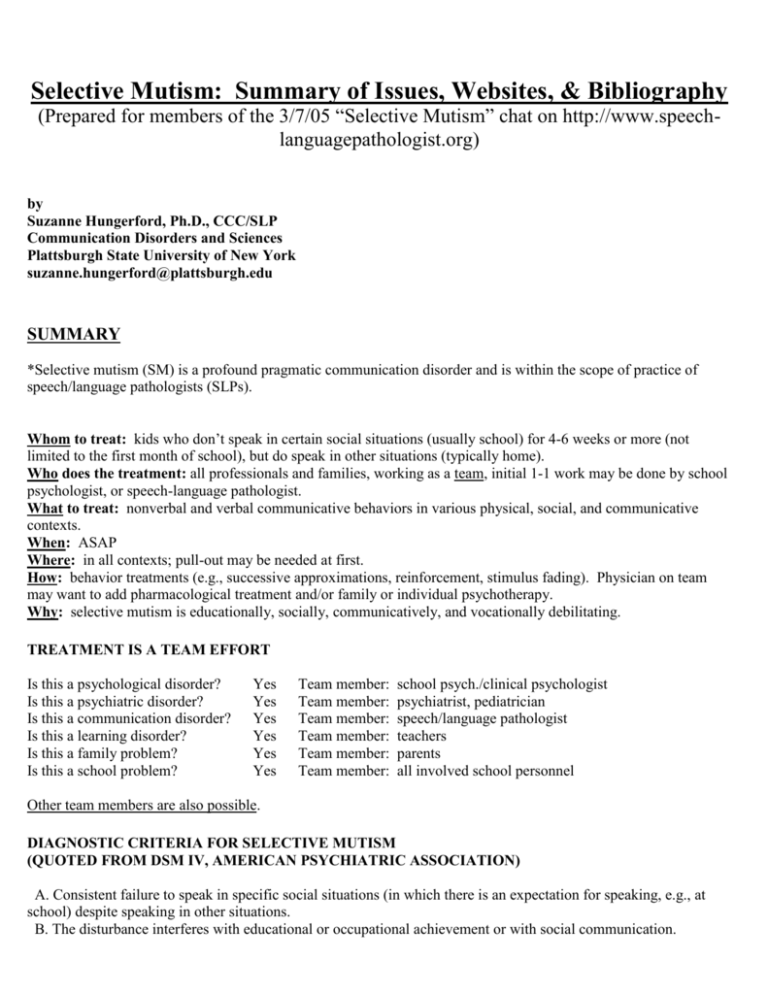
Selective Mutism: Summary of Issues, Websites, & Bibliography (Prepared for members of the 3/7/05 “Selective Mutism” chat on http://www.speechlanguagepathologist.org) by Suzanne Hungerford, Ph.D., CCC/SLP Communication Disorders and Sciences Plattsburgh State University of New York suzanne.hungerford@plattsburgh.edu SUMMARY *Selective mutism (SM) is a profound pragmatic communication disorder and is within the scope of practice of speech/language pathologists (SLPs). Whom to treat: kids who don’t speak in certain social situations (usually school) for 4-6 weeks or more (not limited to the first month of school), but do speak in other situations (typically home). Who does the treatment: all professionals and families, working as a team, initial 1-1 work may be done by school psychologist, or speech-language pathologist. What to treat: nonverbal and verbal communicative behaviors in various physical, social, and communicative contexts. When: ASAP Where: in all contexts; pull-out may be needed at first. How: behavior treatments (e.g., successive approximations, reinforcement, stimulus fading). Physician on team may want to add pharmacological treatment and/or family or individual psychotherapy. Why: selective mutism is educationally, socially, communicatively, and vocationally debilitating. TREATMENT IS A TEAM EFFORT Is this a psychological disorder? Is this a psychiatric disorder? Is this a communication disorder? Is this a learning disorder? Is this a family problem? Is this a school problem? Yes Yes Yes Yes Yes Yes Team member: Team member: Team member: Team member: Team member: Team member: school psych./clinical psychologist psychiatrist, pediatrician speech/language pathologist teachers parents all involved school personnel Other team members are also possible. DIAGNOSTIC CRITERIA FOR SELECTIVE MUTISM (QUOTED FROM DSM IV, AMERICAN PSYCHIATRIC ASSOCIATION) A. Consistent failure to speak in specific social situations (in which there is an expectation for speaking, e.g., at school) despite speaking in other situations. B. The disturbance interferes with educational or occupational achievement or with social communication. C. The duration of the disturbance is at least 1 month (not limited to the first month of school). D. The failure to speak is not due to a lack of knowledge of, or comfort with, the spoken language required in the social situation. E. The disturbance is not better accounted for by a Communication Disorder (e.g., Stuttering) and does not occur exclusively during the course of a Pervasive Developmental Disorder, Schizophrenia, or other Psychotic Disorder. Formerly: “elective mutism” More common in females (3:1). Rare. May last only a few months, or years, or may persist. FACTS ABOUT SELECTIVE MUTISM Speech/language delays/disorders (beyond the pragmatic disorder of selective mutism) may occur in up to 50% of children with SM (McInnes, et al., 2004) Contexts of Mutism o School o Strangers o Children in general o Specific children o Family o Father o Mother o Sibling severe - Selective Mutism - mild % 89 89 42 34 13 11 4 2 (Schum, 2001) Reluctant Speech Shy Normal Communicative reticence is on a continuum frozen statue more severe normal body language, communicative writing less severe Selective mutism can be severe or less severe; involving only verbal communication, or involving verbal, written, gestural communication and spontaneous bodily movements. ASSESSMENT ISSUES Due to the nature of SM, assessment can be difficult. Need to assess: All facets of the pragmatic communication disorder (see below) o Parent interview o Direct observational assessment: school and home, if possible Underlying speech/language disorders o If child points, receptive communication skills may be testable (Lindamood Auditory Conceptualization Test, PPVT, parts of CELF-4, etc.) o Therapist may go to child’s home for testing o Analysis of recorded language/speech sample from home o Narrative analysis of audiotaped narratives (see McInnis, et al., 2004) o Portfolio analysis (artifacts from classroom analyzed) Anxiety o SLP may assess communication-related anxiety by adapting self-report measures used in stuttering o Psychologist may assess anxiety Academics o Portfolio analysis o Achievement testing that requires only nonverbal response Cognitive Psychological Medical ASSESSING THE PRAGMATIC COMMUNICATION DISORDER Communication performance in SM is determined by a complex interplay among variables. These communication pressure variables may differ from child to child. These variables must be taken into consideration when assessing, when designing treatment plans, and when measuring treatment progress. Some of these important variables are: physical context: classroom (with peers present, with therapist alone, with teacher…), principal’s office, playground, school library, hallway, therapy room, mall, home…; type of communication required: sharing personal vs. non-personal information, sharing known information vs. novel, reading a script or book vs. spontaneous conversation, rote vs. spontaneous, highly communicative (sharing information) vs. less communicative (naming a picture, game context), yes/no answer vs. other; characteristics of communicative partner/others present in vicinity: familiarity, number present, gender, peer or non peer, age, social role (teacher, principal, therapist); communicative functions: regulating another’s behavior, social interaction, greeting, joint attention, answering questions, requesting information, etc.. Behavioral regulation typically easier than the social functions of language. Answering questions (non-personal first) may be easier than asking questions. interaction/communication modality: nonverbal turn-taking (e.g., taking a turn in a game), pointing, writing, nodding, whispering, voicing with low volume, voicing with normal volume, playing a toy instrument in a “band” (unvoiced instrument, e.g., guitar, then voiced, e.g., kazoo; or mouth instrument vs. manual instrument), making speech noises in non-communicative contexts (“ch ch ch ch” to go up the ladder, “sssssss” to go down the chute in game; first unvoiced, then voiced) Checklist of Communicative Functions and Means (Items adapted from Prizant, Wetherby & Roberts, 1993) Child’s initial: Rater’s name: Date of sample: Context and activity: Communicative partner: Others present: Indicates joint attention Nonverbally Giving gesture Pointing gesture Showing gesture Other gesture (e.g., reaching, raise hand, push away) Normal proximity to Communicative partner Yes/no head nod/shake Shoulder shrug Shared affect expressed through facial expression Holds object/toy Manipulates object/toy Reciprocal play Parallel play Follows a verbal request for action Answers Yes/No Answers forced choice questions Verbalization (speaking) Communicative Functions (specify): B, S, J, O* * B = Behavioral regulation request object request action protest S = Social interaction request social routine request comfort greeting calling, request permission, showing off W=writing S=spontaneous N=non-verbal (specify) R=requested J = Joint Attention comment request information provide information O = Other V=verbal Global Measure: # Communicative Acts Per Minute/Mode of Communication INTERVENTION ***Most therapy ideas come from psychology/psychiatry. SLPs have a unique perspective and can provide unique contributions to this field. SLPs know that speech is more than “motor movements” to be shaped behaviorally – speaking is a result of a complex interplay between motivation, language competence, social background, cognitive/emotional demands, pragmatic pressures, communicative needs, communicative pressure, communicative competence, etc.. I suggest that we view selective mutism NOT as a deficit in speech, per se, but a more global deficit in communication (verbal/nonverbal). This point of view will lead us to more pragmaticoriented interventions that target the communication deficit, rather than focusing on the production of speech, per se (see “socio-communication intervention model,” below). --SMH EXAMPLES OF THERAPIES: Behavior modification (Pecukonis and Pecukonis, 1991) Fixed ratio- and then variable ratio-reinforcement (primary reinforcers, tokens, social praise) for: Non-verbal attending behaviors Non-verbal imitation (clapping, standing, touching toes) Verbal imitation (vocalizations, noun labels) Functional language (open-ended questions, etc.) Generalization (use of parents and teachers throughout training kept the trainer from being the only discriminative stimulus for speaking) Puppets were used by trainers, parents and children during some of the intervention. Self modeling (“Audio/Video feedforward treatments”) (e.g., Blum, et al., 1998) Children with selective mutism listened to audiotapes of themselves speaking. They brought the tapes from home and repeatedly listened to edited versions of them in situations in which they were not currently speaking (school, community). [A variant of this idea is “video self-modeling.”] The tapes are edited so that they appear that the child is answering a person with whom she/he does not currently speak. And/or they are edited to appear to be made in contexts in which the child doesn’t currently speak (classroom). These authors report rapid success (weeks) in 3 children for whom behavior therapy was unsuccessful. Combination of behavior modification, psychotherapy, and medication (Zoloft; esp. for kids with physical concomitants (“stiffness”) (Schum, 2001) Therapy included: operant conditioning using successive approximations, modeling (siblings, friends), friends from school visit at home, use “talking scale” (described below), rehearsal (reading familiar passage). Psychotherapy focused on anxiety and talking about being brave vs. nervous. Successive approximations (from beginning point to end point): eye contact, head nod, point, noisemakers, write, whisper word, whisper phrase, whisper responses at school, whisper conversation, microphone at school for public speaking. Talking scale: Discusses with child, and ranked speaking situations as being “hard,” “medium,” or “easy”: talking to family, friends or therapist; reading in class, reading in a group, making a video at school, talking to classmates at lunch, giving an interview, etc. Stimulus Fading Many therapists include a “stimulus fading” technique. Once the therapist has the child communicating (say, in a pull-out speech/language therapy room), then, the therapist brings in classmates, etc. (to keep the therapist from being the only discriminative stimulus for speech). Similarly, items and people from home can be brought in to school or therapy to make the school environmental stimuli more like the home (in which the child speaks). Self-reinforcement (Kehle, et al. 1998) Kehle used an edited videotape. The child was instructed to pause the video whenever the tape depicted her verbally responding to the teacher’s questions. After pausing, the child would select a reinforcer (pencils, stickers, etc.) These researchers also played the videotape in the child’s classroom, to increase the expectations for peers that the child would communicate. Socio-communication intervention model for severe selective mutism (Hungerford, et al., 2003) A pragmatic model for therapy that first targets non-communicative, non-verbal reciprocal interaction. Once non-verbal interaction is established, therapy moves on to target reciprocal interaction with greater communicative demands, keeping in mind that communicative pressure can be a result of: type of communication (personal vs. non-personal, sharing known information vs. novel contributions to conversation, reading a script vs. spontaneous conversation); characteristics of communicative partner (familiarity, gender, social role (teacher, principal, therapist)); communicative functions (regulating another’s behavior, social interaction, greeting, joint attention, answering questions, requesting information, etc.); communication modality (nonverbal turn-taking, pointing, writing, nodding, whispering, voicing); and physical environment (classroom, therapy room, school library, playground). Whenever one of these variables changes, making for more speaking pressure, the therapist may need to move down the hierarchy – perhaps again targeting nonverbal reciprocal interaction and moving up the hierarchy to target more interactive, and more verbal behaviors. Each therapy activity should be analyzed in terms of each of the above variables to determine the overall difficulty of the activity (amount of communicative pressure). Very small increases in difficulty should be used. Though the design is pragmatic, the therapy targets are reinforced using a behavioral paradigm. Long-Term Outcomes It appears that there may be two types of SM: transient, in which the symptoms resolve within a year, and chronic, in which the symptoms are longer lasting. Children with long-lasting SM are particularly difficult to treat. Symptoms of SM may be chronic in up to 50% of cases (McInnes, et al., 2004). There are not too many follow-up studies, but here is one positive outcome (from Kehle et al., 1990): “We also brought the formerly mute child to the University to discuss his elective mutism with graduate psychology students. This 6-year-old formerly … mute child confidently walked into a rather large room and sat down at a table in front of approximately 25 strange adults, folded his arms and stated, “well, what is it you want to know?”… after 7 months follow-up indicated that the formerly mute child was functioning extremely well. He freely communicated verbally with his peers and faculty. He also volunteered to assist the authors with other mute children who may be in the district.” Websites http://www.asha.org/public/speech/disorders/Selective-Mutism.htm American Speech Language Hearing Association’s site on selective mutism. www.asha.org If you are an ASHA member, you can access a number of journal articles on selective mutism here, by searching publications. http://www.selectivemutism.org/ (Selective mutism group, childhood anxiety network, Inc.) http://www.acposb.on.ca/mutism.html (Tips for teachers) http://www.anxietynetwork.com/ (The Anxiety Network) http://www.nasponline.org/futures/selmutism.html (“When the Words Just Won’t Come Out”-- Understanding Selective Mutism by Elisa Shipon-Blum, D.O.) Selected References Adams, H., & Glasner, P. (1954). Emotional involvement in some forms of mutism. Journal of Speech and Hearing Disorders. 19. 59-69. American Psychiatric Association (2000). Diagnostic and Statistical Manual of Mental Disorders, Fourth Edition, Text Revision. Washington DC: American Psychiatric Association. Atoynatan, T. H. (1986). Elective mutism: Involvement of the mother in the treatment of the child. Child Psychiatry and Human Development. 1. 17. 15-27. Black, B., & Uhde, T. W. (1992). Elective mutism as a variant of social phobia. Journal of the American Academy of Child and Adolescent Psychiatry. 31. 6. 1090-1094. Blum, N. J., et al. (1998). Case study: Audio feedforward treatment of selective mutism. J. Am. Acad. Child Adolesc. Psychiatry, 37(1), 40-43 Browne, E., Wilson, V., & Laybourne, P. (1963). Diagnosis and treatment of elective mutism in children. Journal of the American Academy of Child Psychiatry. 2. 605-617. Cline, T. & Baldwin, S. (1994). Selective Mutism in Children. London: Whurr Publishers. Ford, Mary Ann; Sladeczek, Ingrid E.; Carlson, John; Kratochwill, & Thomas R. (1998). Selective Mutism: Phenomenological Characteristics. School Psychology Quarterly, v13 n3 p192-227 Publication Year: 1998 Friedman, R., & Karagan, N. (1973). Characteristics and management of elective mutism in children. Psychology in the Schools. 10. 249-252. Giddan, J. J. and Ross, G. J. (1997). Selective Mutism in Elementary School: Multidisciplinary Interventions Language, Speech, and Hearing Services in Schools Volume 28, Issue 2. Pages 127 - 133 Golwyn, D. H., & Weinstock, R. C. (1990). Phenelzine treatment of elective mutism: A case report. Journal of Clinical Psychiatry. 51. 9. 384-385. Harris, H. F. (1992–1993). Elective mutism with accompanying phonological disorder: A case report. National Student Speech Language Hearing Association Journal. 20. 78-82. Hayden, T. (1980). Classification of elective mutism. Journal of the Academy of Child Psychiatry. 19. 1. 118-133. Hill, L., & Scull, J. (1985). Elective mutism associated with selective inactivity. Journal of Communication Disorders. 18. 161-167. Hultquist, Alan (1995). Selective Mutism: Causes and Interventions. Journal of Emotional and Behavioral Disorders, v3 n2, p100-07 Hungerford, S., Edwards, J., & Iantosca, A. (2003). A socio-communication intervention model for selective mutism. Paper presented at the conference of the American Speech-Language-Hearing Association, Chicago. Kehle, T. J., Madaus, M. R., Baratta, V. S. & Bray, M. A. (1998). Augmented self-modeling as a treatment for children with selective mutism. Journal of School Psychology, 36(3), 247-260. Kolvin, I., & Fundudis, T. (1981). Elective mute children: Psychological development and background factors. Journal of Child Psychology and Psychiatry and Allied Disciplines. 22. 219-232. Kratochwill, T. R. (1981). Selective mutism: Implications for research and treatment. Hillsdale, NJ: Lawrence Erlbaum Associates. Krohn, D. D., Weckstein, S. M., & Wright, H. L. (1992). A study of the effectiveness of a specific treatment for elective mutism. Journal of the American Academy of Child and Adolescent Psychiatry. 31. 4. 711-718. Krolian, E. (1988). “Speech is silver but silence is golden:” Day hospital treatment of two electively mute children. Clinical Social Work Journal. 16. 4. 355-377. Lebrun, Y. (1990). Mutism. LondonNew Jersey: Whurr Publishers. McInnes, A., Fung, D., Manassis, K., Fiksenbaum, L. & Tannock, R. (2004). Narrative Skills in Children With Selective Mutism: An Exploratory Study. American Journal of Speech-Language Pathology, Volume 13, Issue 4. Pages 304 - 315. November 2004 Pecukonis, E. V. & Pecukonis, M. T. (1991). An adapted language training strategy in the treatment of an electively mute male child. J. Behav. Ther. & Exp. Psychiatr., 22(1), 9-21. Powell, Shawn; Dalley, Mahlono (1995). When to Intervene in Selective Mutism: The Multimodal Treatment of a Case of Persistent Selective Mutism. Psychology in the Schools, v32 n2 p114-23 Apr 1995 Pustrom, E., & Speers, R. (1964). Elective mutism in children. Journal of the American Academy of Child Psychiatry. 3. 287-297. Author: Schill, Melissa T.; And Others (Spring, 1996). An Assessment Protocol for Selective Mutism: Analogue Assessment. Using Parents as Facilitators. Journal of School Psychology, v34 n1 p1-22 Schum, R. (2001). Selective mutism. Presentation at the American Speech Language Hearing Association Convention, New Orleans, 2001. Schum, R. (2002). Selective mutism: An integrated treatment approach. The ASHA Leader, 7(17), 4-6. Sheridan, Susan M.; And Others(1995). Assessment and Treatment of Selective Mutism: Recommendations and a Case Study. Journal Citation: Special Services in the Schools, v10 n1 p55-78 Shreeve, D. F. (1991). Elective mutism: Origins in stranger anxiety and selective inattention. Bulletin of the Menninger Clinic. 55. 4. 491-504. Shvarztman, P., Hornshtein, I., Klein, E., Yechezkel, A., Ziv, M., & Herman, J. (1990). Elective mutism in family practice. The Journal of Family Practice. 31. 3. 319-320. Smayling, L. M. (1959). Analysis of six cases of voluntary mutism. Journal of Speech and Hearing Disorders. 24. 55-. Strait, R. (1958). A child who was speechless in school and social life. Journal of Speech and Hearing Disorders. 23. 253-254. Thompson, R. (1988). Elective mutism: Identification and differential diagnosis. Texas Journal of Audiology and Speech Pathology. 14. 1. 12-15. Thompson, R. (1989, November). Elective mutism. Paper presented at the Annual Convention of the American Speech-Language-Hearing Association, St. Louis, MO. Wilkins, R. (1985). A comparison of elective mutism and emotional disorders in children. British Journal of Psychiatry. 146. 198-203. Wright, H. L. (1968). A clinical study of children who refuse to talk in school. Journal of the Academy of Child Psychiatry. 24. 603-617.
